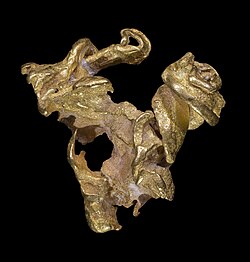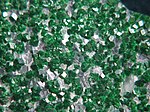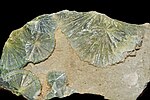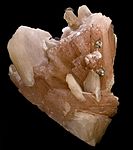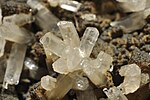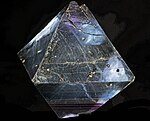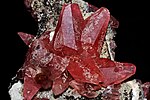| Habit | Image | Description | Common example(s) |
|---|
| Acicular | | Needle-like, slender, and end-tapered prisms growing in a radial/globular fashion. | natrolite, scolecite, yuanfuliite |
| Arborescent | | Tree-like crystals growing similar to branches. | copper, gold, silver |
| Capillary/Filiform | | Hair-like or thread-like, extremely fine | byssolite, millerite |
| Colloform/Nodular/Tuberose | | Rounded, finely banded deposits with irregular concentric protuberances | agate, baryte, sphalerite |
| Concentric | | Circular ring aggregates around a center. This habit is found in cross-sections from reniform/mamillary habits, and also from elongated stalactites of amethyst (quartz), malachites, rhodocrosite, and others | agate, quartz, malachite, rhodocrosite |
| Dendritic | | Root-like, branching in one or more direction from central point | copper, gold, romanechite, magnesite, silver |
| Druse/Encrustation | | Aggregate of crystals coating a surface or cavity, usually found in geodes and some fossils | azurite, celestine, calcite, uvarovite, malachite, quartz |
| Fibrous/Asbestiform | | Extremely slender prisms forming muscle-like fibers | actinolite, asbestos, baryte, kyanite, gypsum, nitratine, stilbite, serpentine group |
| Foliated/Micaceous/Lamellar | | Layered crystal planes, parting into thin sheets | biotite, hematite, muscovite, lepidolite, molybdenite |
| Granular | | Aggregates of diminute anhedral crystals in matrix or other surface | andradite, bornite, scheelite, quartz, uvarovite |
| Hopper | | Outer portions of cubes grow faster than inner portions, creating a concavity similar to that of a hopper | bismuth (artificial), halite, galena |
| Oolithic | | Small spheres or grains (commonly flattened) that resemble eggs | aragonite, calcite |
| Pisolitic | | Rounded concentric nodules often found in sedimentary rocks. Much larger than oolithic | aragonite, bauxite, calcite, pisolite |
| Platy/Tabular/Blocky | | Flat, tablet-shaped, prominent pinnacoid | baryte, feldspar, topaz, vanadinite, wulfenite |
| Plumose | | Fine, feather-like scales | aurichalcite, okenite, mottramite |
| Radial/Radiating/Divergent | | Radiating outward from a central point without producing a star (crystals are generally separated and have different lengths). | aenigmatite, atacamite, epidote, pyrophyllite, stibnite |
| Reticulated | | Crystals forming triangular net-like intergrowths. | cerussite, rutile |
| Rosette/Lenticular | | Platy, radiating rose-like aggregate (also lens shaped crystals) | gypsum, baryte, calcite |
| Stalactitic | | Forming as stalactites or stalagmites; cylindrical or cone-shaped. Their cross-sections often reveal a "concentric" pattern | calcite, chalcedony, chrysocolla, goethite, malachite, romanechite |
| Stellate | | Star-like, radial fibers found inside spherical habits, such as mamillary or reniform. | hematite, pectolite, shattuckite, wavellite |
|





